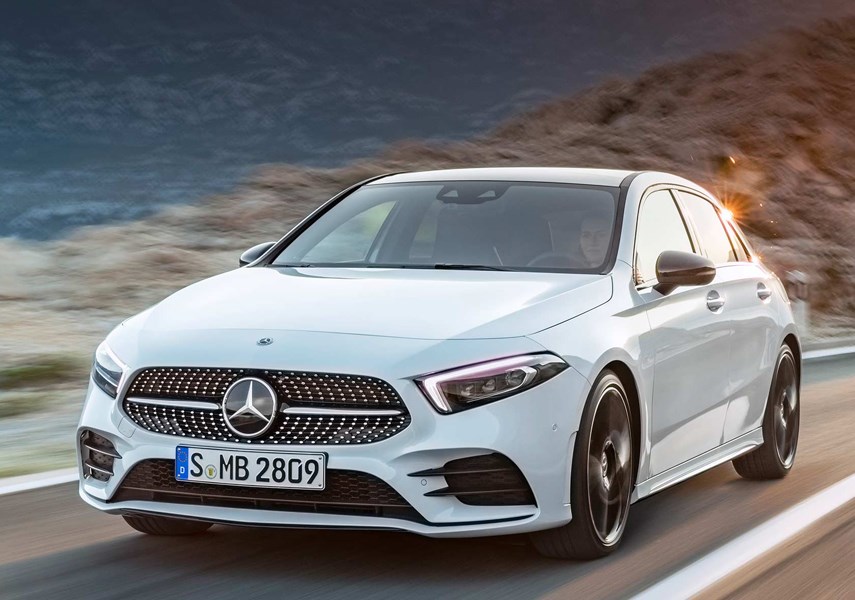The announcement that the Mercedes-Benz A-Class would be coming to North America in the coming year was greeted with joy by fans of small European hatchbacks.
At least, it was until word came out that only the sedan version would be available in the United States. As for Canada? We’re going to get ‘em both.
Now, selling an A-Class in Canada presents a couple of problems.
“What kinda Mercedes-Benz ya got there bud, eh?”
“Yes. A.”
“No, ya hoser, I mean like what kind is it eh?”
“Um. Yeah, that’s what I said. A.”
“Whaddya mean, eh?”
“I said A!”
Gloves dropped, fisticuffs and jerseying ensue, here come the linesmen to break it up.
The A hatchback isn’t the only small Mercedes that you can buy in Canada but not in the U.S. Currently, Mercedes-Benz Canada also sells a wagon variant of the C-Class: the C400 wagon. It’s a pretty great machine if you prefer the lower centre of gravity of a car but still need to haul around a crossover’s-worth of cargo.
Why don’t they sell such a thing in the U.S.? Well, the market’s got a slightly different flavour down there. In point of fact, they can’t even spell “flavour” correctly. Sedans are where it’s at in the U.S., so Mercedes has decided not to roll out a smaller wagon to go with their E-Class variants.
Bu what if sales of the C400 wagon and A-Class hatchback suddenly take off in the Great White North? Well, you can bet Mercedes-Benz U.S.A. will be taking a good look at whether they might add those models to the range. It’s a bit like Canada is the perfect place to dip your toe in the pool before diving headfirst into the market.
Besides having a smaller population than the U.S., Canadians are also a little slower to trade their vehicles in. You’d think that, taking the country as a whole, the salty roads of the Eastern provinces would force people to swap into new cars more often, but we tend to hang on to our old jalopies. It’s probably a combination of being a slightly penny-pinching nation, and of being so swamped with taxes we’ve got less disposable income to throw around.
As such, we sometimes get offered cheaper variants of existing cars, or especially cheap models to tempt us into showrooms. The most obvious example presently on sale is the Nissan Micra. It’s peppy but slow, cheap but cheerful, and economical above all. Just the kinds of attributes Canadians seem to love.
Back in the days of Fargo and Mercury, domestic brands like Ford and Chevrolet used to have Canada-specific models that were smaller than their U.S. counterparts, or had fewer features. Sure, we got high performance versions of the Beaumont, but most Canadian cars were a little de-contented.
That’s one reason we still get some of the cheap stuff, or cars like the Acura EL and CSX, which were basically slightly nicer Honda Civics. The really good stuff comes when we’re not just being pandered to, but being used as a test market for the U.S.
Let’s stick with Honda for a bit. Back in the early 1960s, Honda was looking to get into the automobile exportation business and achieve the same success they were having with motorcycles. Instead of stampeding into the U.S. market, where Datsun would have a bit of a struggle initially, Honda headed for Canada instead.
Thus, while the Americans were mostly still driving big lead sleds, Canadians got to have a go at cars like the Honda S600. A sprightly little two-door machine that came in either roadster or coupe variants, the S600 punched above its weight with a rev-happy engine and bantamweight nimbleness.
I’ve had the chance to talk to a few S600 owners over the years, and they were pretty much all universally happy with their memories of the little car. The engine was a little delicate, and tricky to get tuned right, but there was a lightweight joy here that would eventually trickle into the more successful Honda Civic. How lucky we were to get a go at things first (the U.S. market had to wait until the 1970s).
Perhaps less fortunate was the arrival of Hyundai with the Pony, in the mid-1980s. The Pony was a half-decent car by 1970s standards – but it was being sold in the ‘80s. Still, it was being sold cheap, and Canadians snapped them up.
When bits started falling off them, most Pony owners realized that the cars were cheap for a reason. To their credit, dealerships tried to patch up the problems as best they could, and enough goodwill persevered such that the brand got a toehold in the market. Hyundai took the lessons they learned in the Canadian market and headed southwards. Today, they’re a well-respected brand, capable of branching out into genuine luxury with the Genesis line.
The new A-Class hatchback sounds like a far better proposition than the Pony, and should be something of a rival to the VW GTI. In particular, Volkswagen should be worried about how the spartan interior of the GTI will contrast with the fresh look of the A-Class and its high-tech accouterments.
As a vehicle that’s testing the waters for a larger market, we should just be glad Canadians have the chance to try out something new. And, when the Chinese auto manufacturers start putting feelers out, perhaps there’ll be a chance for us to be the first wave to determine whether manufacturers like Geely and BYD are up to the task.
The next S600, or just another lame Pony? We’ll have to wait and see.
Brendan McAleer is a freelance writer and automotive enthusiast. If you have a suggestion for a column, or would be interested in having your car club featured, please contact him at mcaleeronwheels@gmail.com. Follow Brendan on Twitter: @brendan_mcaleer.



